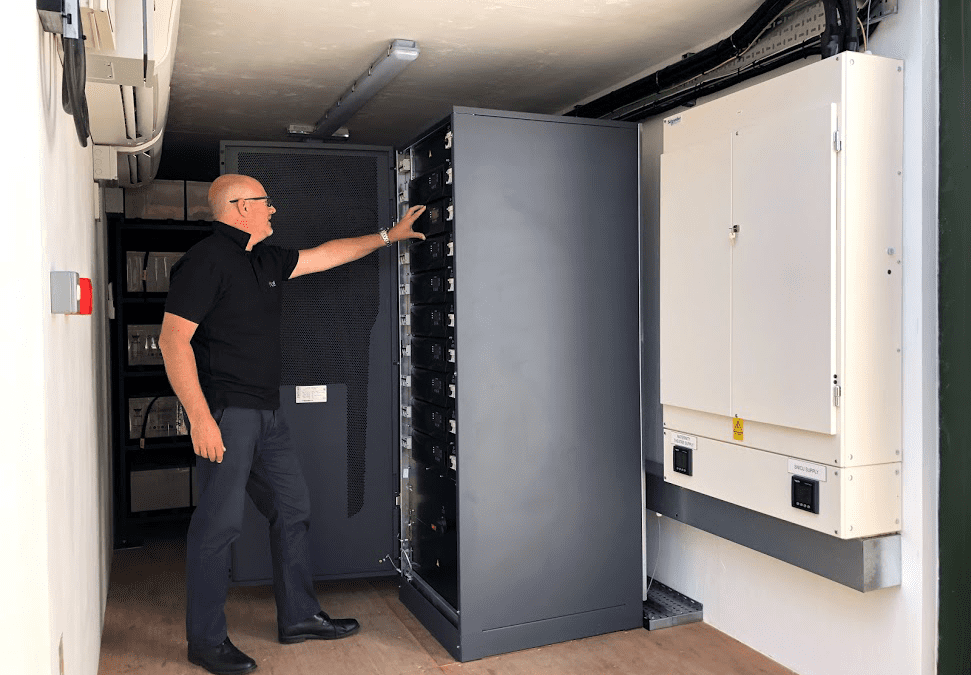The rise of containerised UPS systems is the key to rapid and flexible deployment of critical infrastructure. Shipping containers have been used to house UPS systems for many years. The military were quick to recognise the advantages of a self-contained, purpose-built, secure source of power protection that could easily be delivered onto the side of a mountain if necessary! These days, containers can be used both inside and outside buildings to rapidly deploy self-contained mini datacentres which can be added to as required. However, we are now also starting to see the demand for containerised UPS systems pop-up more and more and in locations from hospitals to dock yards to airports.
We recently installed a containerised UPS at a Hospital in Somerset designed to protect power to the special care baby unit. The hospital required a space-saving and cost-effective solution to protect the critical power to this important ward which offered the highest levels of power availability and a 60-minute run time in the event of a power failure. Instead of incurring the significant cost of a new building, 20-foot shipping container was converted and supplied as a secure UPS plant room. This is a typical example of how shipping containers can offer a bespoke solution designed specifically to meet the requirements of clients and data-housing is no exception.
Most of the installations we have completed are simply UPS systems with no data, but the advantages for datacentres looking to house both data and UPS within a small footprint are the same. To accommodate the rise in the need for edge datacentres, storing information close to source, in the future they may become a necessity for many organisations.
Where space is a premium, a purpose-built shipping container can provide a complete customised solution. The key point is that no planning permission is necessary, and installation can occur particularly quickly: normally installation can be completed in around a month, but it can be less than a week if necessary!
Containers are secure structures which can easily be fenced off. They can be painted to blend in with the surroundings (camouflaged in the case of the military!), or alternatively, wrapped with company logos and branding to stand-out.
Even with modification, containers are significantly cheaper to purchase than to develop a brand-new building to house the required equipment. They do need air-conditioning due to the tight space, however, often not as much as a heated building. Where building space is limited, they can offer the ideal solution.
Containers offer a robust and solid temporary structure. Siting the container close to the area which requires back up power is usually straightforward and reduces the cost of cabling. They can also be a great option to extend a comms room or put a facility in a remote or awkward location.
Only recently we supplied a 20kVA N+1 UPS, expandable up to 100kVA allowing for a three-hour runtime, which was fitted into a wiring cupboard at another hospital. This shows how modular, front access UPS systems with internal batteries now represent such a small footprint they can be flexibly deployed into tight spaces where previously this would have been unheard of. This has a significant development in the rise in containerised UPS systems. The flexible nature of modular UPS systems can take full advantage of floor to ceiling space.
Equipment can be installed prior to the container being craned into position, however because most UPS are so small and light these days, installation after the container has been delivered avoids the need to bold kit down for safe transport.
Modification of the container is necessary. They need to be insulated, boarded and set onto concrete foundations, usually slightly raised to remove the risk of flooding. They need to be lined and finished to prevent condensation. However, this has advantages too, a white melamine finish creates an environment similar to a clean room, which adds to the longevity of the equipment being housed.
Bespoke design for the battery racks optimising the configuration for ease of access and maintenance of both the UPS and batteries is usually required. Maximising the use of the floor to ceiling space to create a workable area, ensuring there is enough room to allow for the rest of the equipment including DC isolation, bypass panel, UPS distribution panel and building management service (BMS) which all need to be accessed readily for maintenance is important. The shipping container also needs to have room for air conditioning units plus emergency lighting if necessary.
If containers are placed remotely, then it is possible to take advantage of remote monitoring for maintenance. In the cases of military installations with limited access, personnel can be easily be trained to replace a module and any necessary repairs can be completed off-site, eliminating any downtime.
As well as the advantages outlined, containerised UPS enable a pay as you grow approach. Instead of high investment in additional real estate, it is possible only to invest in what is required. Containers can be used like Lego blocks to expand as required. They offer a customisable, cost effective and rapid deployment of power protection. For the edge datacentres of the future, it is likely they will become a popular option for organisations looking to house data close to the source.
Article originally featured in Networks Europe January 2020

